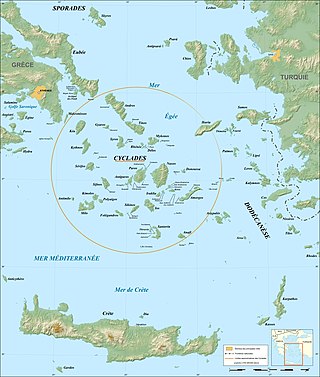
Cycladic culture was a Bronze Age culture found throughout the islands of the Cyclades in the Aegean Sea. In chronological terms, it is a relative dating system for artifacts which serves as a roughly contemporary dating system to Helladic chronology and Minoan chronology (Crete) during the same period of time.

Mycenaean Greece was the last phase of the Bronze Age in Ancient Greece, spanning the period from approximately 1750 to 1050 BC. It represents the first advanced and distinctively Greek civilization in mainland Greece with its palatial states, urban organization, works of art, and writing system. The Mycenaeans were mainland Greek peoples who were likely stimulated by their contact with insular Minoan Crete and other Mediterranean cultures to develop a more sophisticated sociopolitical culture of their own. The most prominent site was Mycenae, after which the culture of this era is named. Other centers of power that emerged included Pylos, Tiryns, and Midea in the Peloponnese, Orchomenos, Thebes, and Athens in Central Greece, and Iolcos in Thessaly. Mycenaean settlements also appeared in Epirus, Macedonia, on islands in the Aegean Sea, on the south-west coast of Asia Minor, and on Cyprus, while Mycenaean-influenced settlements appeared in the Levant and Italy.

Nemea is an ancient site in the northeastern part of the Peloponnese, in Greece. Formerly part of the territory of Cleonae in ancient Argolis, it is today situated in the regional unit of Corinthia. The small village of Archaia Nemea is immediately southwest of the archaeological site, while the new town of Nemea lies to the west.

Helladic chronology is a relative dating system used in archaeology and art history. It complements the Minoan chronology scheme devised by Sir Arthur Evans for the categorisation of Bronze Age artefacts from the Minoan civilization within a historical framework. Whereas Minoan chronology is specific to Crete, the cultural and geographical scope of Helladic chronology is confined to mainland Greece during the same timespan. Similarly, a Cycladic chronology system is used for artifacts found in the Aegean islands. Archaeological evidence has shown that, broadly, civilisation developed concurrently across the whole region and so the three schemes complement each other chronologically. They are grouped together as "Aegean" in terms such as Aegean art and, rather more controversially, Aegean civilization.
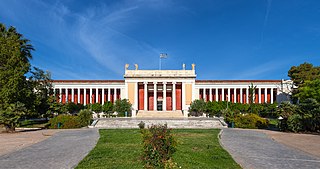
The National Archaeological Museum in Athens houses some of the most important artifacts from a variety of archaeological locations around Greece from prehistory to late antiquity. It is considered one of the greatest museums in the world and contains the richest collection of Greek Antiquity artifacts worldwide. It is situated in the Exarcheia area in central Athens between Epirus Street, Bouboulinas Street and Tositsas Street while its entrance is on the Patission Street adjacent to the historical building of the Athens Polytechnic university.

Elizabeth Bayard French, FSA, also known as Lisa French, was a British archaeologist and academic, specialising in Mycenaean Greece, especially pottery and terracotta figurines and the site of Mycenae. She was the first woman to serve as director of the British School at Athens (BSA).

A heroön or heroon, also latinized as heroum, is a shrine dedicated to an ancient Greek or Roman hero and used for the commemoration or cult worship of the hero. They were often erected over his or her supposed tomb or cenotaph. They were erected from the time of archaic Greece to the Augustan Roman period, and as far afield as Ai-Khanoum in Afghanistan.

The Archaeological Museum of Nafplio is a museum in the town of Nafplio of the Argolis region in Greece. It has exhibits of the Neolithic, Chalcolithic, Helladic, Mycenaean, Classical, Hellenistic and Roman periods from all over southern Argolis. The museum is situated in the central square of Nafplion. It is housed in two floors of the old Venetian barracks.

The Archaeological Museum of Aegina is a museum in Aegina, Greece, founded on 21 October 1828 by Ioannis Kapodistrias, the first governor of independent Greece.
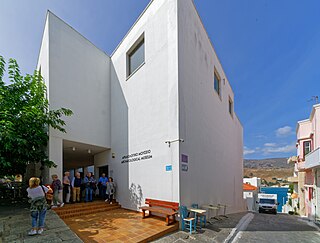
The Archaeological Museum of Andros is a museum in Andros, Greece, established in 1981 following a donation from the Basil and Elisa Goulandris Foundation.

The Archaeological Museum of Delos is a museum on the island of Delos, near Mykonos in the South Aegean, Greece. It is noted for its extensive collection of statues unearthed in the surrounding area of the ancient site, which has been declared a UNESCO World Heritage Site. Although the museum has a considerable collection, it does not contain all of the items found in Delos: a large quantity are on display in Athens at the National Archaeological Museum.
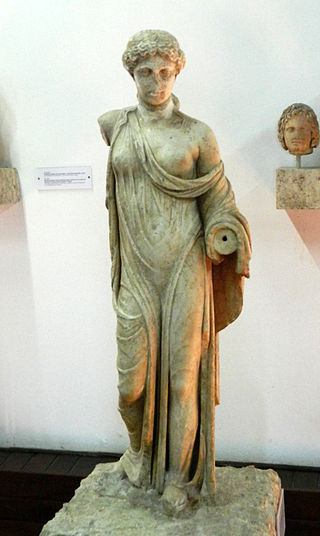
The Archaeological Museum of Lamia is a museum within the archaeological site of Lamia Castle in Lamia, Greece. The museum is housed in a refurbished barracks built in 1830 by King Otto of Greece. It presents prehistoric and Classical antiquities, covering the Neolithic era, Helladic period, Early Iron Age, Archaic, Classical and Hellenistic periods.
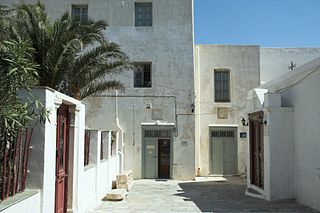
Archaeological Museum of Naxos is a museum in Naxos Greece.

Neolithic Greece is an archaeological term used to refer to the Neolithic phase of Greek history beginning with the spread of farming to Greece in 7000–6500 BC, and ending around 3200 BC. During this period, many developments occurred such as the establishment and expansion of a mixed farming and stock-rearing economy, architectural innovations, as well as elaborate art and tool manufacturing. Neolithic Greece is part of the Prehistory of Southeastern Europe.
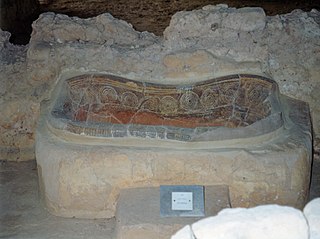
The Palace of Nestor was an important centre in Mycenaean times, and described in Homer's Odyssey and Iliad as Nestor's kingdom of "sandy Pylos".

The Archaeological Museum of Pella is a museum in Pella in the Pella regional unit of Central Macedonia. The building was designed by architect Kostas Skroumpellos and is on the site of the ancient city of Pella. It was completed in 2009 with the support of the Greece's Third Community Support Framework.

Euonymeia, also known by its medieval name Trachones, and by its modern colloquial Ano Kalamaki, is a historic settlement and currently a residential neighborhood within the suburban town of Alimos in the southern part of the Athens urban area, Greece. The area is an inland part of the south Athenian plain, situated between the foothills of Mount Hymettus and the southern coastal zone of Athens on the Saronic Gulf. The land is characterized by limestone hills and streams running from Hymettus toward the coast.
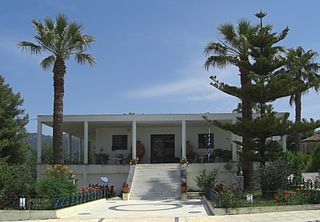
The Archaeological Museum of Chora is a museum in Chora, Messenia, in southern Greece, whose collections focus on the Mycenaean civilization, particularly from the excavations at the Palace of Nestor and other regions of Messenia. The museum was founded in 1969 by the Greek Archaeological Service under the auspices of the Ephorate of Antiquities of Olympia. At the time, the latter included in its jurisdiction the larger part of Messenia.

The archaeological site of Menelaion is located approximately 5 km from the modern city of Sparta. The geographical structure of this site includes a hill complex. The archaic name of the place is mentioned as Therapne.

The Archaeological Museum of Milos is a museum in Plaka on the island of Milos, in Greece. Its collections include exhibits dating from the late Neolithic to the Byzantine period. The unique is collection of ancient Cycladic art, especially numerous findings from Phylakopi on Milos, from early Bronze Age to the late Bronze Age. The best pieces from Phylakopi are in the Ashmolean Museum (Oxford), in the British Museum, and in the National Museum of Athens and elsewhere around the world.


























